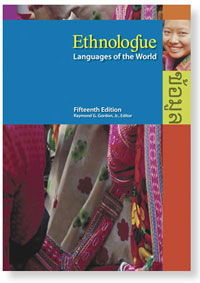Book Notes
 Ethnologue; Languages of the World, 15th Edition, Raymond G. Gordon, Jr., editor (Dallas: SIL International, 2005), 1272pp.
Ethnologue; Languages of the World, 15th Edition, Raymond G. Gordon, Jr., editor (Dallas: SIL International, 2005), 1272pp.
From A Fala de Xálima, which is spoken in Portugal, to Zyudin, a dialect of Komi-Permynk spoken in the Urals, Ethnologue has distinguished itself as the best single source of information about all the known languages of the world. Richard Pittman produced the first "edition" in 1951, a mimeographed version that identified 46 languages. This 15th edition raises the bar to 7,299 known languages, and supercedes the 14th edition of 2000 with over 50,000 updates and corrections, including 103 previously unidentified languages.
The purpose of the Ethnologue comes closer to a catalog than an encyclopedia: "to provide a comprehensive listing of the known living languages of the world." That is no small task given the controversial issues surrounding the nature of language. How does one define a language? What criteria differentiate a dialect from a distinct language? How to track the 497 languages that are classified as "nearly extinct" and that face "language death" because they have fewer than 50 speakers? The Ethnologue tackles all these issues and more in its introduction, including such matters as deaf sign language for 119 languages.
After its introduction and overview (pp. 7–13), Ethnologue contains six major sections. An initial section presents general statistical summaries in a table format (pp. 15–36). We learn, for example, that although there are some 94 "language families," six "major" language families encompass two-thirds of all known languages and five-sixths of the world's population. Or again, Papua New Guinea is the most "linguistically diverse" country in the world with 820 languages among its 3.67 million people. Nor do these languages constitute mere sterile statistics. In one of the most volatile and war-torn regions of the world, two of the smallest and least linguistically diverse countries, Rwanda (fifth least diverse) and Burundi (seventh least diverse), are sandwiched between two of the largest and most linguistically diverse countries, Democratic Republic of Congo (seventh most diverse) and Tanzania (fourth most diverse). The second section is the largest in the book, listing all known living languages by geographical area and country (pp. 39–672), including brief comments about the language based upon 31 different variables—for example, the ethnicity or religion of its speaker population, the related dialects, bilingualism, age groups, and so on. I especially enjoyed looking at the language maps of the world in the third section (pp. 673–887), where a dot represents a language, giving one a sense of what you might think of as "linguistic diversity density." Some parts of the world map are crammed and crowded with overlapping dots, while other parts have large sections where a single language or two dominates. The fourth section grocery lists the 7,299 languages alphabetically (pp. 891–1229). A language code index (pp. 1231–1270) assigns each language a three-letter code, which is now used by the ISO (ISO 639-3) as the international standard for language identification. A final index lists the countries of the world alphabetically by name (pp. 1271–1272).
A new edition of the Ethnologue is planned for every four years. In the mean time, see www.ethnologue.com for a searchable data base of all the content of this print edition.


